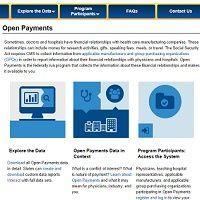Article
Open Payments Debuts: 6 Takeaways
Author(s):
The Centers for Medicare and Medicaid Services on Tuesday published a cache of physician payment data covering the last 5 months of 2013. The data set is vast, but an early look at the site shows it has strengths and weaknesses.

The Centers for Medicare and Medicaid Services on Tuesday published a cache of physician payment data covering the last 5 months of 2013.
The database is an effort to allow the public to see whether their physician has received payments — in cash, royalties, food, or in-kind services – from pharmaceutical and medical device companies.
The disclosure of the information came about as a result of a provision of 2010’s Affordable Care Act.
“Using this new data, it is now possible to conduct a wide range of analyses of payments made by drug and device manufacturers,” said Shantanu Agrawal, MD, deputy administrator at CMS and director of the agency’s Center for Program Integrity.
Agrawal said the data could have the effect of discouraging inappropriate payments to doctors, but he said it’s up to the public to decide whether certain financial relationships are of concern.
However, the public’s ability to make those judgments will depend a lot on whether they use the site and relatedly, whether they are navigate the site to find the data they want. So far, a handful of things are evident:
The financial information is vast… The database covers 4.4 million payments to 546,000 physicians and more than 1,300 teaching hospitals. Altogether, $3.5 billion worth of payments are included. The data can be sorted by type — such as ownership and investment payments, speaking fees or complimentary food and beverages – and users are able to search by a number of factors such as physician name, ZIP code, specialty or drug or device company. The site also has visualization capabilities, giving users the chance to view the data in a number of chart and graph styles.
…with one big caveat. While a vast amount of financial data is available, about 40% of the records don’t identify the physician to whom the payment was made. CMS said it removed identifying information from those records when it was unable to match financial information with physician information or when the records weren’t available for prior review by the physician in question. In other words, while the database provides a good macroeconomic perspective, it’s difficult for an individual user to know whether the record for their physician is complete. CMS says it plans to make all of the data fully identifiable next year.
Accuracy remains a huge issue. Though half a million physicians are included in the database, less than 5% (26,000) of those physicians registered with the Open Payments system to review their data before publication. Less than one-third (400) of teaching hospitals registered. That means most of the data hasn’t been double-checked by the physicians it pertains to. The American Medical Association notes physicians had only 45 days to review the data, and even though CMS provided an extension, AMA says many physicians didn’t receive timely notice of the extension.
Even when accurate, the data is sometimes inconsistent. In its initial review, the news site ProPublica found that many companies, such as Johnson & Johnson, had data listed under the names of several subsidiaries. Meanwhile, the site notes, the names of drugs were not always uniform or accurate.
Users should be prepared to invest time. Users who visited the site Tuesday found it loaded slowly, often requiring users to wait around 30 seconds for the initial data to load, and then wait again when searches were performed. The site appeared to be running more quickly on Wednesday morning. The data appear in spreadsheet form, and while it’s comprehensive, users should be prepared to scroll past several fields of unwanted information before they get to their desired data. In short, while a wide range of analysis is possible, users who aren’t spreadsheet experts may have difficultly wading through the data.
Open Payments isn’t going anywhere. Although the system has caused headaches for physicians and users alike, the data represents a new paradigm that isn’t going away in the foreseeable future. CMS plans to continue releasing this data on an annual basis, and with studies showing more and more patients use the internet to help them choose a doctor, there’s a good chance the public will become accustomed to utilizing this database… as long as they are persistent enough to deal with the website’s flaws.




